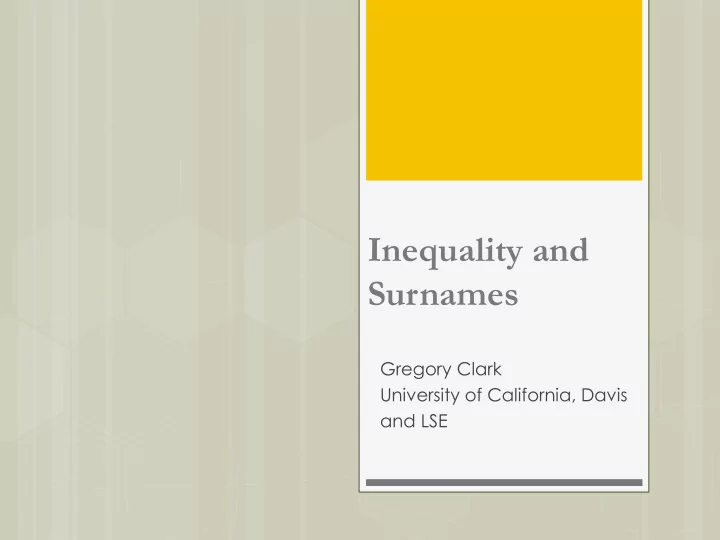

Inequality and Surnames Gregory Clark University of California, Davis and LSE
Simple Measure of Social Mobility Correlation between parents and children on any measure of social status 0 implies complete mobility 1 implies complete rigidity
Social Mobility and Inequality closely linked For a given set of shocks to income or wealth each generation (e), long run distribution of outcomes depends on intergenerational correlation b 𝑤𝑏𝑠𝑗𝑏𝑜𝑑𝑓(𝑓) 𝑊𝑏𝑠𝑗𝑏𝑜𝑑𝑓 𝑧 = 1−𝑐 2
Conventional Picture of Social Mobility
Implications, conventional estimates Mobility Rates High Share of social status variation inherited low – 4% Scandinavia, 22% USA
Implications, conventional estimates There is a social mobility problem . Mobility rates too low in some societies. Enormous human potential squandered. Social Democratic Nordic countries are achieving faster social mobility than free market USA
Implications, conventional estimates What matters to social success ? Culture Education Social networks Not genetic inheritance of abilities
Limitations Looks just at one generation Looks just at individual aspects of status
Surname Method Measure social mobility by tracing status by surname lineages – e.g. Clark, Smith, Bazalgette Surnames link us to previous generations through the patriline – in England we can link some people to their ancestors of 1066 – 32 generations E.g. Norman surnames Montgomery, Baskerville , Punchard
Surname Method Based on current mobility measures common surnames should rapidly lose status information The rate at which they loose that information – the rate of social entropy - can be translated into the intergenerational correlation of status Surnames track one line of descent, but that line assumed representative (assortative mating)
Surprising and universal finding Surnames move to average status very slowly – 10- 15 generations Implied intergenerational correlation of status 0.7- 0.8
Table 2: Rare Oxbridge versus non-Oxbridge Surnames, 1800-29 Oxbridge Non-Oxbridge Agassiz Brickdale Agnerv Bodgett Anquetil Brooshooft Allbert Boolman Atthill Bunduck Arfman Bradsey Baitson Buttanshaw Bainchley Breckill Barnardiston Cantis Bante Callaly Bazalgette Casamajor Barthorn Capildi Belfour Chabot Bavey Carville Beridge Charretie Bedborne Cavet Bleeck Cheslyn Bemond Chanterfield Boinville Clarina Berrton Chesslow Boscawen Coham Bideford Chubham Bramston Conyngham Bisace Clemishaw
Relative Oxbridge Attendance for Elite Rare Surnames 1800-29 64 0.82 32 Relative Representation 0.83 16 8 0.77 4 0.77 2 1 1530 1590 1650 1710 1770 1830 1890 1950 2010
Family vs Surname Wealth Correlation, England Period of Death Individual Wealth Surname Wealth Correlation Correlation 1888-1917 0.48 0.71 1918-59 0.41 0.69 1960-87 0.41 0.73 1999-2012 0.46 0.83
Patriline – what about daughters?
Assortative Mating Pre-1880 (richer lineages) – Wealth, England
Example of surprising persistence of status – Darwin great-great-grandchildren 10 children, but only 27 great- great-grandchildren 11 notable enough to have Wikipedia pages/Times Obits 6 university professors, 4 authors, a painter, 3 medical doctors, a well-known conservationist, and a film director
Countries England, 1300-2012 Sweden, 1700-2012 USA, 1920-2012 Chile, 1950-2012 India, 1860-2012 Japan, 1860-2012 China, 1650-2012 Taiwan, 1949-2012 Costa Rica, 1950-2014 Australia, 1870-2014 Hungary, 1860-2017 Russia, 1879-2017 Barcelona, 1500-1860
Intergenerational correlation measured through surnames High 0.7-0.8 Little variation across societies and epochs
Conventional versus Surname Estimates of Status Persistence, 1950-2012 1 Intergenerational Correlation 0.8 0.6 0.4 0.2 0
Sweden as another example Elite surnames from 1600-1800 Counts/Barons Untitled Nobility Latinized Surnames
Conventional Picture of Social Mobility
Riddarhuset, Stockholm
Figure 3: The History of Ennoblement in Sweden 3,000 Number of Families Nobles Created 2,000 Net Stock Families 1,000 0 1600 1700 1800 1900 2000 Source: Almenberg and Dreber, 2009, 178.
Aristocratic Surnames Domestic - embodying status elements such as Gyllen (gold), Silfver (silver), Adler (eagle), Leijon (lion), and Ehren (honor) Leijonhufvud Gyllenstierna Oxenstierna Ehrensvärd
Latinized Surnames Celsius Aquilonius Arrhenius Boethius Bruzelius Cnattingius
Representation of Surname Types Among Doctors, 1890-2011 8 Relative Representation 4 Titled Nobles Other Nobles 2 Latinized Correlation 0.72 1 1900 1920 1940 1960 1980 2000
Elite Surnames in the Swedish Royal Academies 0.87 64 Relative Representation 16 Elite Correlation 0.87 4 ..son Correlation 0.87 1 1740 1770 1800 1830 1860 1890 1920 1950 1980 2010 0.25 0.87 0.0625 0.015625 Cohort
Summary Surname b Estimates by Period, Sweden Group 1700-1900 1890-1979 1950-2012 Attorneys - - 0.71 Physicians - 0.67 0.88 University Students 0.78 0.85 0.66 Academicians 0.89 0.75 0.84
Hungary, 1946-2017 1.0 1945 1955 1965 1975 1985 1995 2005 2015 Elite Surname Mean ρ = 0.86 0.5 ..y versus Top 20 Fit v top 20 0.3 Generation
Why are the conventional and surname results so different? Conventional estimates focus on individual aspects of status Surnames are capturing what happens to underlying overall status
Social Status Across Multiple Generations
For each individual: Status phenotype – measured status on variety of aspects Underlying status genotype – status that is transmitted to next generation – can be inferred from the status of your lineage
Surname Estimates Long run social mobility Social mobility of social groups – ethnic, racial, religious, immigrants
More Fundamental Question – what transmits social genotype? Family Resources? Family Culture? Social Networks? Genes?
Surprising Evidence – most social status transmission is genetic Patterns of inheritance Adoption studies Groups that marry endogamously How elites get formed Shocks to family size in England 1800-1880
Social status USA 2012 – Doctors per 1000 14 12 Relative Representation 10 8 6 4 2 0
Conclusions There is equality of opportunity in most societies Most social ability biologically inherited – and gets rewarded This is not a pessimistic result But it is an argument for limiting inequalities.
The Son Also Rises. Surnames and the History of Social Mobility
Recommend
More recommend